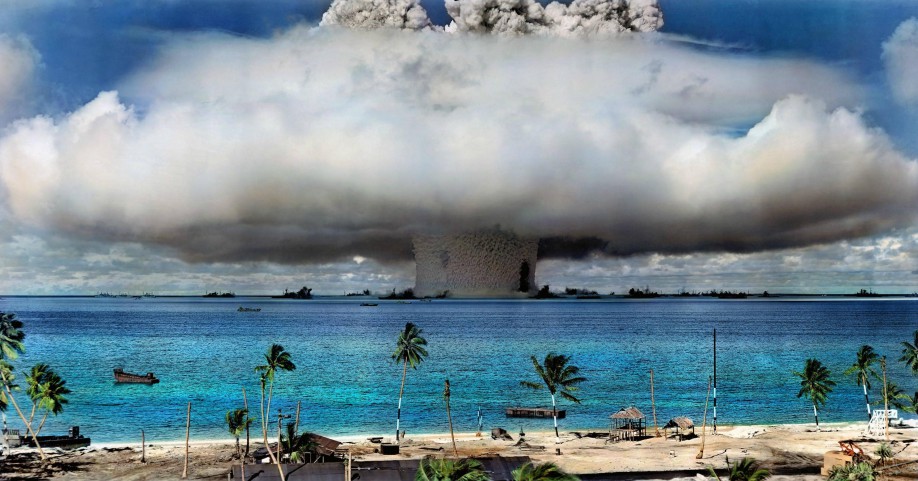Nuclear Tests
Nuclear test explosions are carried out to document the function, explosive power and effect of nuclear weapons under development. When manufacturing a new type of nuclear weapon or when carrying out changes to existing weapons, you want to ensure that everything is working perfectly.
There are two agreements that regulate nuclear weapons tests, the Partial Test Ban Treaty (PTBT) and the Comprehensive Test Ban Treaty (CTBT). The latter has not yet entered into force. Test explosions are also prohibited in the UN Treaty on the Prohibition of Nuclear Weapons (TPNW).
The majority of states that have developed nuclear weapons have carried out tests at various locations around the world, thereby publicizing their nuclear weapons possession and declaring themselves as nuclear weapons states. The only nuclear weapon state that has not publicly tested a nuclear weapon is Israel.
Nuclear weapons tests are also used to show off the country’s scientific and military strength to the outside world, adding a political aspect to these tests.
By test detonation, you can find out how the weapons work and how they work under certain conditions, like underwater, and how different environments react to nuclear explosions and so on.
Who has done what?
According to the organization Comprehensive Test Ban Treaty Organization, CTBTO, there have been 2,060 nuclear test explosions since the United States tested the first nuclear weapon in July 1945. Over 500 test explosions have been conducted in the atmosphere or underwater. The rest of the test blasts have been done underground.
| Land | Quantity | Year |
| USA | 1032 | 1945–1992 |
| Sovjet Union/Russia | 715 | 1949–1990 |
| France | 210 | 1960–1996 |
| Untied Kingdom | 45 | 1952–1991 |
| China | 45 | 1964–1996 |
| North Korea | 6 | 2006–2017 |
| India | 2 | 1998 |
| Pakistan | 2 | 1998 |
| Israel | 0 | – |
Atmospheric tests
Atmospheric testing has most often been carried out by detonating nuclear warheads in tall towers, from balloons, from barges, over/on islands, or by dropping them from aircraft. There have also been cases of nuclear weapons being launched from rockets at really high altitudes. Bombs detonated at low altitude, such as the early atmospheric tests from the ground or from a barge, produced large amounts of radioactive fallout.
During the 1950s and 1960s, most of the tests took place in the atmosphere. Tests in the atmosphere are the easiest and cheapest to carry out and evaluate. However, tests in the atmosphere mean that large amounts of radioactive substances were spread around the Earth by the wind and formed a radioactive coating on the ground. The radioactive substances from the tests are still present today and can still cause cancer.
The environmental consequences led people to worry about how the tests affected their health. Around the world, a strong opinion emerged in favor of a ban on nuclear weapons tests and, in particular, on tests in the atmosphere. With the Partial Test Ban Treaty of 1963, the US, the Soviet Union, and the United Kingdom stopped testing nuclear weapons in the atmosphere.
Underwater tests
Underwater testing of nuclear weapons means that a nuclear weapon detonates underwater or just below the surface of the water. This type of test was done to investigate the effects of nuclear weapons against waterborne craft, such as submarines or underwater torpedoes.
Underwater tests emit large amounts of radioactive rain and mist that poison individuals, nearby ships, and the aquatic environment.
Underground tests
Underground tests refer to nuclear charges that are detonated below the surface of the ground, at varying depths. After the Partial Test Ban Treaty was negotiated and banned all other forms of test blasts in 1963, underground testing became increasingly common. Over 75 percent of all nuclear tests have been conducted underground.
If an underground test is carefully controlled and contained, it produces smaller amounts of radioactive fallout than an atmospheric test. However, underground tests lead to other consequences. Among other impacts, these tests run the risk of creating holes in the surface that cause large amounts of radioactive substances to spray into the air with soil and dust.
Underground tests can create to craters forming below the ground surface with only thin “roofs”, which risk collapsing later and then releasing radioactive substances. Vigorous underground testing can also lead to seismic activity, meaning they can trigger earthquakes, tsunamis and landslides.
Subcritical tests
To continue to develop nuclear weapons the US, Russia, the United Kingdom and France carry out other forms of nuclear tests, including computer simulations, fusion experiments and so-called subcritical tests. China is also suspected of having conducted at least one subcritical test.
Subcritical tests involve experiments with fissile material that can be used for nuclear weapons in amounts where the critical mass is not reached. This means that the nuclear reaction cannot maintain itself and an actual explosion does not occur. Smaller amounts of fissile material are used in these experiments. It could be about a few kilos of weapons-grade plutonium or uranium compressed by conventional explosives. This design has at least some parts in common with a real nuclear weapon, the designs and materials of which are being tested.
Sources and more information
CTBTO, CTBTO
Subcritical Experiments, Frank von Hipple, Bulletin of Atomic Scientists, 2012





